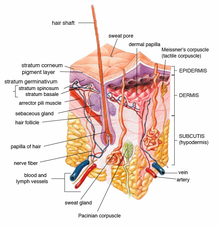This article includes a list of general references, but it lacks sufficient corresponding inline citations. (March 2011) |
Chromhidrosis is a rare condition characterized by the secretion of colored sweat.[2] It is caused by the deposition of lipofuscin in the sweat glands. Cases of red, blue, green, yellow, pink, and black sweat have been reported.
| Chromhidrosis | |
|---|---|
| Other names | Colored sweat[1] |
 | |
| Specialty | Dermatology |
Usually, chromhidrosis affects the apocrine glands, mainly on the face and underarms. A limited number of treatment options exist, including regular application of capsaicin cream, and prolonged relief may be provided by botulinum toxin treatment. Chromogenic pigments produced by bacteria (Corynebacterium in particular) are implicated in this condition, but their exact role still requires careful microbiological elucidation.
Chromhidrosis of the eccrine glands is rare; it occurs mainly after the ingestion of certain dyes or drugs.
See also
editReferences
edit- ^ James, William; Berger, Timothy; Elston, Dirk (2005). Andrews' Diseases of the Skin: Clinical Dermatology (10th ed.). Saunders. p. 179. ISBN 978-0-7216-2921-6.
- ^ Freedberg, Irwin M.; Eisen, Arthur Z.; Wolff, Klauss; Austen, K. Frank; Katz, Lowell A.; Katz, Stephen, eds. (2003). Fitzpatrick's Dermatology in General Medicine (6th ed.). New York: McGraw-Hill. p. 708. ISBN 978-0-07-138076-8.
Further reading
edit- Schwarz, T; Neumann, R; Duschet, P; Brückler, B; Klein, W; Oppolzer, G; Bardach, H; Gschnait, F (1989). "Apokrine Chromhidrose" [Apocrine chromhidrosis]. Der Hautarzt (in German). 40 (2): 106–9. PMID 2714985.
- Marksjr, J (1989). "Treatment of apocrine chromhidrosis with topical capsaicin". Journal of the American Academy of Dermatology. 21 (2 Pt 2): 418–20. doi:10.1016/S0190-9622(89)80050-7. PMID 2474015.
- Bartels, Eva (2008). "Farbkodierte Dopplersonographie der Vertebralarterien. Vergleich mit der konventionellen Duplexsonographie" [Color coded Doppler sonography of the vertebral arteries. Comparison with conventional duplex sonography]. Ultraschall in der Medizin. 13 (2): 59–66. doi:10.1055/s-2007-1005277. PMID 1604294.